In the late 1990's I bought a Klepper Aerius Expedition foldable kayak with factory sailing kit from Sweetwater Kayaks in St Petersburg, FL. I thought it was the neatest thing in the world and still do, but it gets little use because my rotomolded plastic boats are so much easier to use and put away. It takes me over 20 minutes to assemble the boat, almost 30 if I add the rudder, and about 45 minutes if I add the leeboards, mast and sails to the mix.
I took the picture at right the last time I used the boat and it gives some idea of why this is the case. The boat consists of a wooden frame and a skin composed of hypalon rubber and cotton canvas. The bow and stern frames are partially assembled, inserted into the skin, then the remaining pieces are attached. There are two inflatable bags hung in nylon sleeves along each side of the boat and blowing them up tensions the skin over the frame.
It looks great for a boat that is approaching 20 years old, partially because it is seldom used and partially because I go through a long ordeal each time I use it to remove all salt and water before returning it to its bags and storing it in an air-conditioned closet.
It is a great boat because it allows me to do things I could not do with a normal kayak and this past weekend was a good example. I have wanted to kayak at the Weedon Island Preserve in St. Pete for some time now after seeing lots of great pictures of the place posted by a Facebook friend. I also wanted to attend the opening of the McKay Creek Boat Shop at St Pete Heritage Village to support boatbuilder Mike Jones and the other people who made the Clark Mills commemorative exhibit a reality.
The problem I faced was that I did not want to try to park my truck with a long kayak hanging out of the bed, nor did I want to risk theft of any of my kayaks. The solution: lock my kayak in the cab of the truck. Only one of my kayaks could solve those problems: the Klepper foldable.
Weedon Island Preserve is a beautiful place with lots of little islands and bays in which to get lost.
It is also loaded with fish and birds and more than a few fishermen. Staying in the back channels and bays and away from the main channel, I saw large schools of mullet and some redfish and snook lurking around the little islands.
I rounded one island and found myself almost on top of some fishermen who were working the far side of the point. I apologized for spooking any fish along the mangrove shore and they were good-natured about it. It turned out that they needed a kayaker at that moment, as a bobber with a live shrimp had just broken free. They asked me to retrieve it for them.
After giving the fishermen back their rig, I continued winding my way through the little islands and bays, heading east toward Tampa Bay.
I was trying to quietly glide in close enough to this Great Blue Heron to get a good picture but apparently got a bit too close for comfort and managed to get an interesting takeoff picture instead.

Out at the mouth of Bayou Grande (NOAA chart 11416) I found a beach that was barely bigger than my boat and got out to stretch. Most of the islands are actually just mangrove clusters on the flats with no dry ground but that one had some higher ground with cabbage palms and other trees. I wanted to wander around a bit but knew I was already running late and would probably miss the ribbon-cutting at the McKay Creek Boat Shop so I headed back to the launch area.
On the way, I encountered a couple of groups of a dozen or more kayakers and there was another group receiving instruction and preparing to launch when I arrived at the park's floating dock. There was also some kind of charity running race going on in the park so finding a quiet place where I could disassemble my boat was going to be a problem.
I loaded it into the back of the truck and headed over to the Sweetwater Kayaks shop, where a friend who works there gave me permission to use their ample lot. I had my own little patch of grass under a shade tree in which to break down the boat and get it into its transport bags and into the cab of the truck.
This was only the second time that I can remember disassembling the boat and putting it in bags with salt and water on it. I usually keep it assembled until I reach a place where I can clean and dry it. I knew that the time spent putting it away would be longer than my time spent paddling, so the work-to-play ratio was off. I decided then that I would use the boat again the next day and then clean it up and put it away to restore the proper work-to-play ratio.

I headed on over to Heritage Village, where some kind of festival was going on with lots of arts and crafts vendors and food and drink booths set up throughout the park. I was immediately glad that I did not have a kayak hanging out the back of my truck. Finding a place to park a full-sized pickup was going to be hard enough!
The main reason I wanted to attend the McKay Creek Boat Shop grand opening was my interest in seeing the original prototype of Clark Mills' finest creation, the Sun Cat. My interest grew out of meeting Mike Jones during my service as self-proclaimed Head Jib Trimmer In Charge and three-time winner of the Sun Cat National Championship Regatta. I came up with the Sun Cat Nationals and the title of HJTIC after some discussions on the internet about how to make a Sun Cat sail faster. The racing class rule I came up with is designed to foster innovation in that area. It says only that you must sail a hull that is arguably a Sun Cat hull.
OK, so the whole thing was designed to make a mockery of sailboat racing in general and the speed of Sun Cats in particular. Racing sailboats is, let's face it, a somewhat silly pastime. I enjoy it and it does improve your skills, but it's still silly and nothing could be sillier than a group of Sun Cats skippered primarily by sailors who have spent little or no time racing. It was the most fun I had during the time we owned our Sun Cat.
The original Sun Cat differs from the ones built during the 1970's and 80's by the Sun Cat Company and from the post-2000 boats built by Com-Pac Yachts in several ways. It has a wooden hull. All of the later boats are fiberglass. It had a 30-foot mast and carried a 190 square foot Marconi sail. The 1970's and 80's boats had a 165 square foot Marconi sail and modern Com-Pac Sun Cats have a 150 square foot gaff-rigged sail.
They are all different below the waterline as well. This wooden prototype has a centerboard with a pennant led to the roof of the removable hard top. I asked Mike Jones where the pennant was supposed to go when sailing with hard top removed and even he did not know and had never seen the boat without the top. This suggests to me that it was more removable in theory than in practice. The 1970's and 80's boats had bilge boards inside the inner edges of the cockpit benches. Com-Pac Sun Cats have a ballasted shoal keel with a stainless centerboard.
They're all still arguably Sun Cat hulls so are legal for class-racing with whatever kind of sail and underwater foils someone might wish to use. Even the guys who had to ruin my "Jib Trimmer" joke by actually adding jibs.

The McKay Creek Boat Shop also features Clark Mills' best-known design, the Optimist Pram. It was designed to be cheap and easy to build and Mills donated the design to the Optimist club in 1947, never accepting any royalties for it. The idea was to have a class of boats that could be easily built by a bunch of sailors (not necessarily skilled woodworkers) so that kids would have something in which to learn basic sailing skills. Tens of thousands of us did.
The boat at right looks very much like the one I owned in the late 1970s. The design was such a huge success that Optimist Prams are now a major racing class for kids. No one who is serious about racing them builds their own any more. The boats are manufactured in fiberglass and buying one that is fully equipped for competitive racing now requires a five-figure budget. I wonder whether Clark Mills would consider that such a huge success? He just wanted to get kids out sailing. So many have been built that it's pretty easy to find a cheap, old beater pram for that purpose. That's consistent with the original purpose of the design. The expensive race boats with fancy sails and hardware represent what happens to most popular racing classes, where winning becomes more important than just sailing. I made up the ridiculous Sun Cat Class rule mostly to mock that kind of outcome.
The thing about kids is, they grow up and get bigger. They need a bigger boat with two sails and more to learn. To address that need, Clark Mills designed the Windmill. The one at left was donated to McKay Creek Boat Shop by the Clearwater Community Sailing Center. The information placard on the boat contains the following quotation from Clark Mills:
"When I was asked to design a boat for pram sailors to graduate to, I thought about a fast sharpie. Sailors that graduate from the pram are going to be young teenagers. They are going to be tired of the pram and are going to want the most dangerous, go-fast thing they can find. It will have to be able to out-sail the boats that already exist in the same size range."
It sounds to me like Mills remembered well what it was like to actually be a teenager! Immortal, invincible, and compelled to prove it to the world. The long, lean Windmill looks appropriately fast and dangerous to me. The Windmill was also designed to be cheap and easy for amateurs to build.
Clark Mills' particular form of genius in designing both the Opti and the Windmill was that he did not just understand how the boat must perform, he understood how to actually get them on the water. If that's the goal, lots of questions beyond appearance and sailing capability quickly arise. Questions like: can our club afford some of these? Can we build them? Once built, can we carry them around the yard, or at least have the older kids do it? The Opti had to be stable and safe because the parents are making the choices at that age. The Windmill had to be dangerous because the teenagers start making the choice to sail or not. The ultimate compliment to a designer has to be when people spend their time and money to put a boat on the water. The International Optimist Dinghy Association has about 170,000 registered boats and many thousands more are out there, unregistered. Though not as numerous, the Windmill Class is still popular after all these years. My hat's off to Clark Mills for putting so many boats on the water, even if the tremendous success has led to racers making the cheap little pram absurdly expensive.

The other boat on display at the McKay Creek Boat Shop is a Snipe named Honey. The Snipe is a class-racer designed in 1931 by William Crosby. Clark Mills built over 40 of them over a twenty year period beginning in the late 1940s. The display placard on Honey features a picture of owner Francis Seavy standing next to the boat with the entire boat covered with trophies, silver bowls, platters, placards, and ribbons won over a long racing career. Honey is in original condition, just as she was last raced, and looks like a piece of fine furniture.
It was good to see these pieces of local sailing history on display in St. Pete Heritage Village. I plan to go back when I can spend more time checking out the other historical buildings on the site and wandering the neighboring Florida Botanical Garden.

I arrived home too late, too hungry, and too tired to embark on the project of properly cleaning the Klepper kayak and putting it back in the closet. Instead, I put it back together and decided to go for a morning paddle the next day. I had not been to Prairie Creek in a while and wanted to go check on the population of wild orchids.
The picture at right is what I like best about paddling early in the day. There's just something about the morning light on the trees and the reflection off glassy water that you can't see any other time of day.
Loggers got most of the giant cypress trees from creeks like this one over the years but they missed a few in Prairie Creek. The one in this picture is about three feet in diameter over most of its length.

Prairie Creek has some of the most interesting Cypress knee formations I have seen. They are taller and skinnier than most others. The tallest one in the picture at right has some vegetation wrapped around it from this past Summer's high water. It's a few feet above the current water level but that was nothing compared to what I found further upstream where the creek is narrower and the surrounding land higher.
This dead Cypress tree shows the tannin stains from the wet season a good 8-10 feet up the trunk. In places I saw water stains and dead palmetto leaves even higher up eroded banks. There were new sand bars and one former peninsula had been turned into an island that is now passable on both sides.

After paddling up the creek a ways, I started to encounter overhanging oak branches with orchids on them. The only kind I have seen around here are Florida Butterfly Orchids, Encyclia tampensis, which is a bit odd because Charlotte County is excluded from the map of their range on the linked page about them. Most grow on the bottoms of oak branches over the creek but I found the one at right on the side of the tree with the morning sun shining through the branches to light it up.
It's a bit out of focus because the auto-focus on my camera seemed to think I wanted a picture of the moss instead. I arrived a bit too late in the year to see the flowers, which bloom in Summer. You can see some seed pods hanging but the flowers are long gone. Judging by the high water marks on the trees, paddling up here this past Summer would have been quite a challenge.
I paused on the edge of a sand bar to eat a banana and drink some water shortly after taking that picture. When I looked up from peeling my banana, a log was in front of my boat that had not been there before. I quickly realized it was no log, it was an alligator about 8 feet long. Most large alligators are afraid of people and look at me warily before fleeing. This one was focused on me and did not seem the least bit afraid. It seemed to be looking at me as a potential breakfast. I quickly gulped down my banana and threw the peel at the gator. After an uncharacteristic moment's hesitation, it ducked under the water. I decided it was a good time to leave the breakfast bar and continued upstream.
After paddling about an hour and forty minutes upstream, it was time to head back. Before turning around, I got the screen shot at left of the map with blue dot at my position on my iPhone. In the lower left corner of the picture you can see the bridge where Washington Loop Rd crosses Prairie Creek, my launch point. It took about an hour and twenty minutes to return downstream.

On the way back down, I spotted this rope swing that I had somehow passed without noticing on my way up. I almost passed it by without taking a picture, then noticed the concrete block up on the shore. It's obviously there to provide a slightly higher launching point, making the ride a bit more thrilling. It made me grin. Some things about teenage fun have not changed since Clark Mills designed the Windmill to be fast and dangerous, and never will!
I stepped out of the boat for a few minutes to stretch and took this picture of my boat on the shore. The boat looks good, the reflection is nice, but I waited too long. That magical morning light had given way to midday glare. Oh well, it was a great weekend of tropical boating in the Klepper kayak! It's bag in the bags in the closet, awaiting its next adventure.
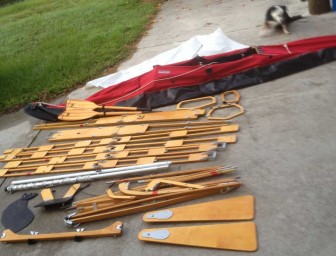
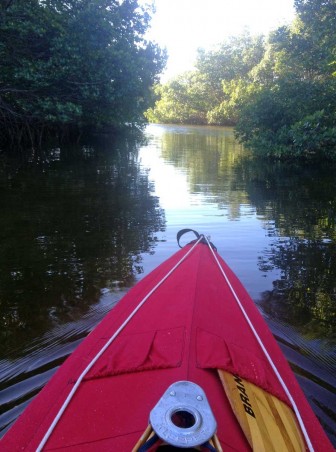
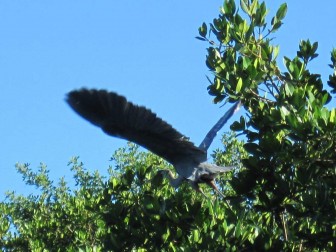
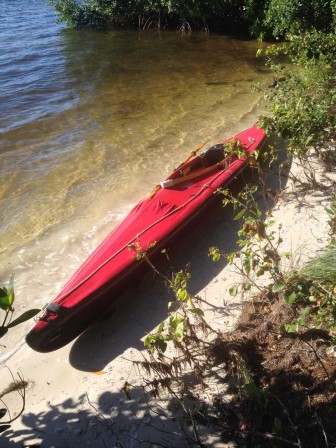
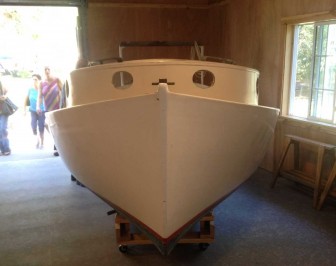
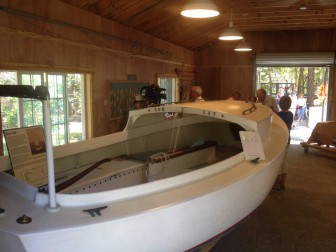
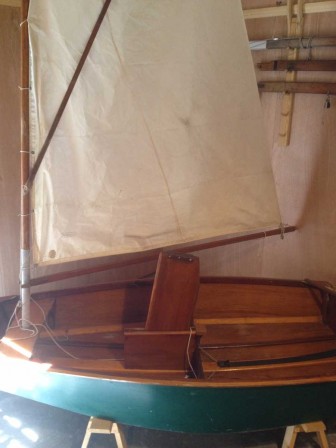
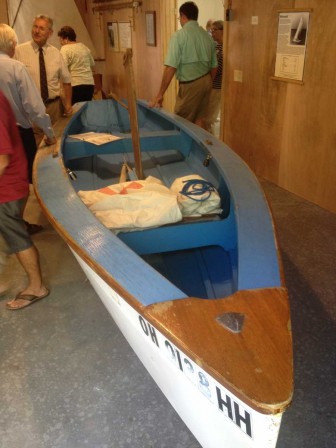
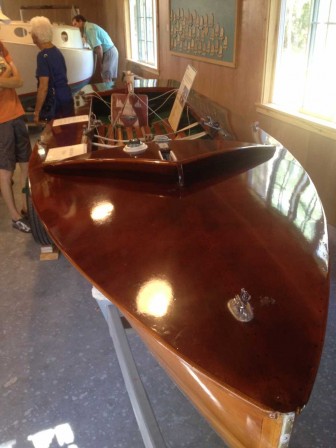
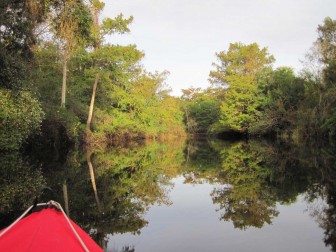
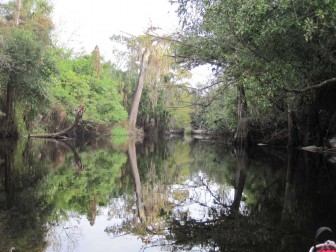
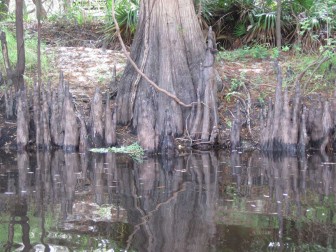
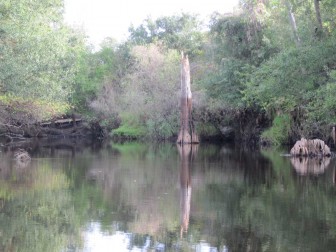
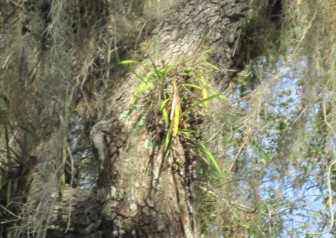
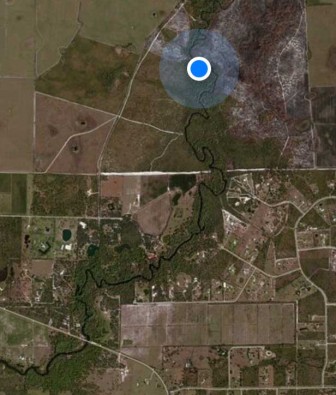
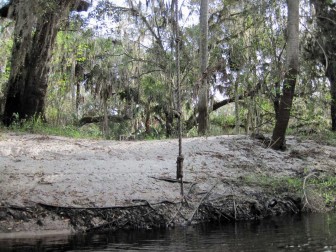
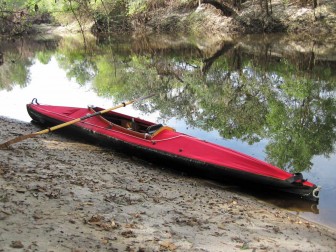
Leave a Reply
You must be logged in to post a comment.